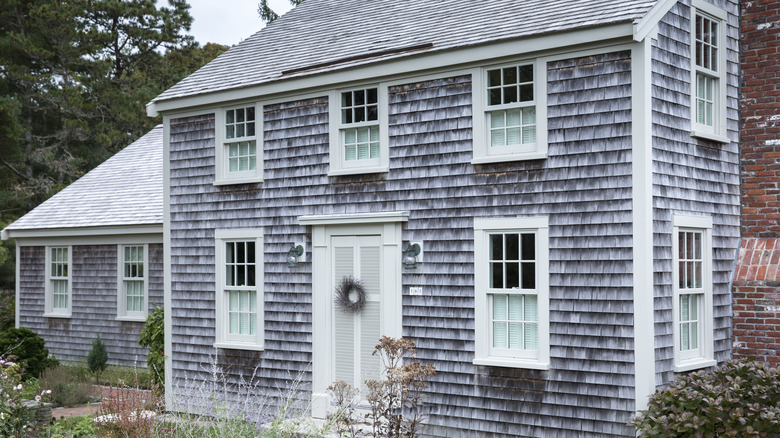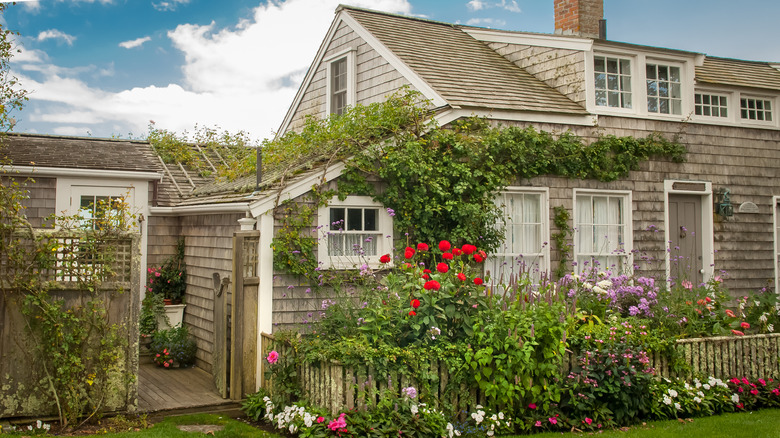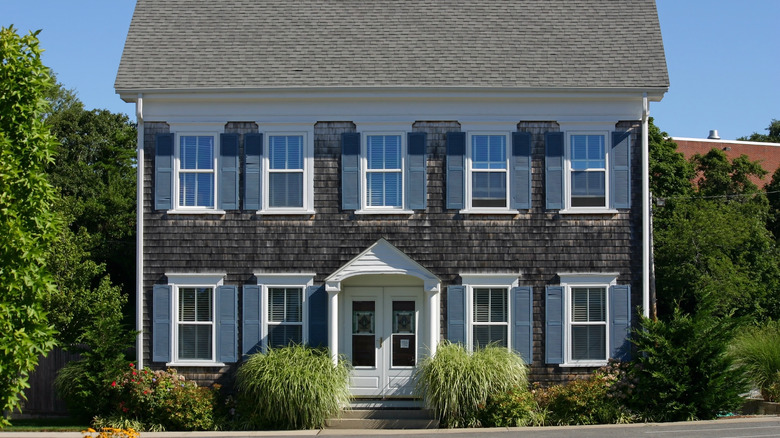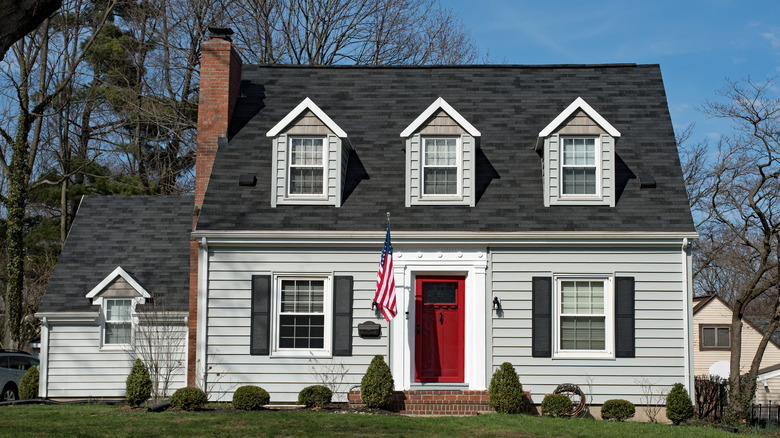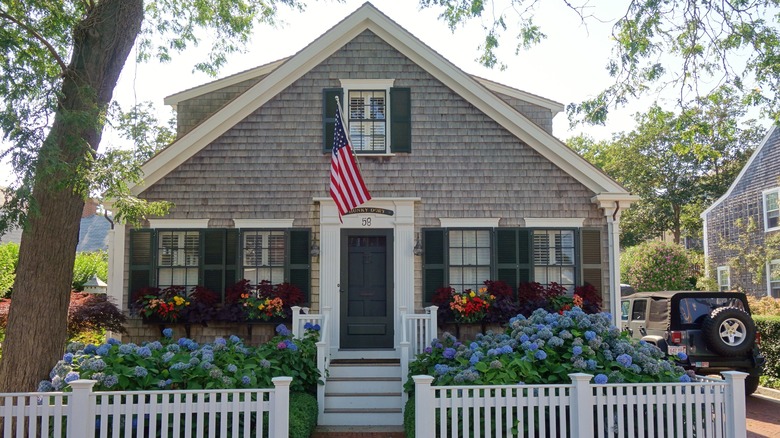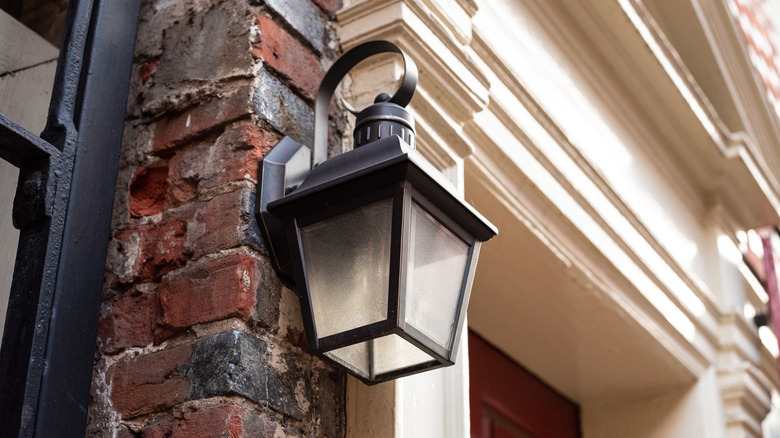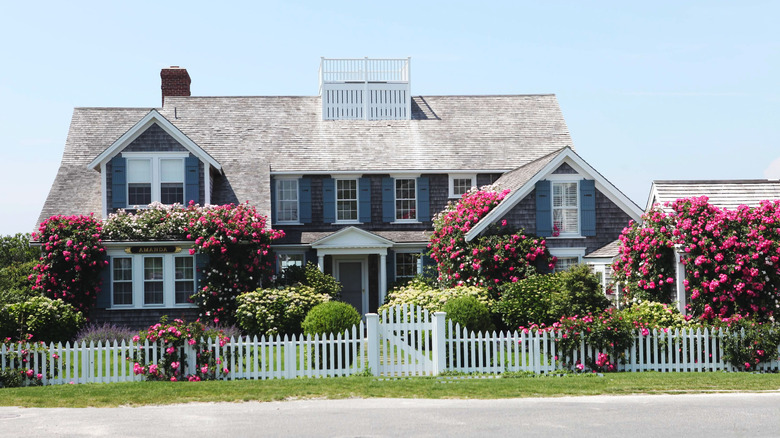What Is A Cape Cod Style House And What Does One Look Like?
There's nothing quite like driving up the coast of a New England beach town, taking in the sprawling mansions — and the absolutely out-of-this-world architecture that went into each and every one — dotted along the shore. But there's also something simple, understated, and homier just around the corner, in neighborhood after neighborhood: Cape Cod style homes.
These homes are certainly more modest, but no less special — and they're definitely more popular than a beachside mansion. A quick drive through any New England suburb (we're not just talking about the Cape here, believe it or not!) will inevitably have you passing by Cape house after Cape house, all somewhat similar in style and yet still so unique. Whether you're thinking of buying one of these beauties or just toying with the idea of a late summer rental, there's plenty to learn about the classic Cape style home.
What is a Cape Cod style home?
Never seen a Cape house before? Considering the fact that they've been around since the Pilgrim days, we're willing to bet you have — and you just don't know it! Take a cruise through Massachusetts or Rhode Island, and you have your answer.
Cape style homes aren't exactly the product of a viral trend (did someone say tiny homes?), but that's what makes them so classic. Per CapeCod.com, the Cape style home evolved from the needs of early settlers in the 1600s, who were looking for a bare-bones housing option: something with a few walls and a roof to get their family comfortable and, well, settled. They've traditionally been smaller and modest homes with minimal extra details and less fancy finishes.
After World War II, Capes began to get a little bit bigger and families and their needs grew, too. They quickly became a staple starter home for middle class couples and families looking to get their foot in the real estate market door, thanks to their simple style (which translated directly into a cheaper cost). Nowadays, newer, bigger builds of this timeless, budget-friendly option are still popping up along the shores and in the suburbs, it's safe to say this style isn't going anywhere.
What does a Cape Cod house look like?
Trying to spot a Cape Cod house from the street? Think of these three elements: shingles, symmetry, and a steep, sloped roof. These qualities can be found in just about any Cape, whether it was built centuries ago or yesterday — and that's because it works, and looks great!
According to HGTV, Cape homes are two stories, with low ceilings, a small attic up top, and a central, narrow staircase. The exterior of older builds often features wooden, single shingle siding, typically in a distressed brown or gray tone. Some newer builds incorporate brick, but in beach towns, shingles are more common.
Capes also showcase symmetry, with large, peaked windows — known as dormers — coming out of its staple sloped roof. A chimney is also often right in the middle, dividing the two, and centering the angled attic. The rest of the windows on the house's exterior also mirror one another, adding to the general curb appeal of Cape Cod style.
What are the different types of Cape Cod houses?
Despite having a timeless style, Capes have evolved over the years to a few different subcategories, says My Move.
The first style, which was the popular pick among early settlers, is the half Cape. This variation is the smallest of the three. It strays a bit from what we consider a common Cape style home today because it isn't as perfectly symmetrical — instead, it features the front door on one side, with two traditional windows to the other side. These were often the jumping off point for new, middle class homeowners to add on to as their families grew.
A three-quarter Cape also ditches the symmetry a bit, with the front door off center and lined up with the staple chimney. On one side is one window, and on the other is two — it's quite literally the equivalent of adding another window onto the half Cape.
The Double Cape is the most popular style nowadays, with the front door in the center of two pairs of windows. The chimney is also lined up perfectly in the middle or off to one side, giving it the symmetrical feel we associate with Cape Cod homes.
How are Cape Cod style homes decorated?
Given the fact that they're called Cape Cods, it's no secret that these homes have a breezy, beachy feel through and through. Even if one is further inland in a suburban town, you can expect a nautical vibe with touches of traditional, rustic elements peppered throughout the interior and exterior.
The distressed siding lends a hand to the beachside feel, but other common features in Cape Cod homes are shiplap and cedar accents, says Homenish. It's unlikely that you'd find gaudy or ornate decor in one of these homes, aside from a column or two touching upon the traditional theme.
According to Home Edit, many Capes feature wood trim, but in more modern takes, it's bright white to contrast any other timeless pieces in the home. The outlet also notes that natural materials are the best to decorate with in Cape Cod homes, since it highlights those wood elements and brings the build back to its early roots.
What kind of lighting is in a Cape Cod house?
For a Cape Cod style home, feeling cozy is key — and when it comes to feeling comfortable in a home, one of the best places to start is the lighting. A Cape house may start to feel closed off with harsh lights or grandiose fixtures because of its smaller, boxed rooms and low ceilings, so lighting is key to complimenting the space.
SFGate explains that in most Capes, you'll find lantern lighting, which is a nod to the style's early roots. Wall sconces, outdoor light posts, and hanging fixtures all tend to have the same lantern-like look — some are even antiqued and repurposed in older homes. Instead of bright white light, Cape homes typically use warm-toned lanterns to make the space inviting and comfortable. Many lighting brands even have their own Cape Cod inspired lines, like this collection from Tin Bin made up of weathered reproductions from the early days!
What are the pros and cons of a Cape house?
The average Cape Cod home may not be a mansion, but that doesn't mean it isn't great — if you're looking for a beautiful place with character, it's an easy and effortless starting point.
Homenish broke down the downsides of owning a Cape house, and they're as minimal as the decor you'd find in one. The rooms are small and a bit boxy, which makes it easy to grow out of for young families. Adding on rooms isn't all that easy, either, since it's so catered to a specific flow and symmetrical feel. The worst con, though? Get ready for a hot summer — Cape Cod homes are notorious for poor airflow, so window air conditioner units are a must (and nothing ruins that gorgeous curb appeal more than an AC hanging out front).
On the flip side, however, Cape houses are designed for the New England winter. With their sloped roof and weather-resistant shingles, homeowners can have some peace of mind during those far-too-frequent blizzards. They're also cheaper due to their smaller size and catered towards young families, making them the ideal backdrop for a classic, cozy childhood. And the best part? They've been enjoyed and in style for centuries — you'll be proud of the home you own for as long as you live in it!
